Part Two: Union-Castle Line 1900-1945

 In 1900, the fastest Union-Castle Line express liner with lavender hull and vermilion red funnel with a black top took a few hours over fifteen days to reach Cape Town from Southampton. Thus, it was essential for the crew to keep passengers happy and amused on the long voyages with a variety of games e.g. egg and spoon race, tug of war, deck quoits, frog races, knocking each other off a ‘bolster’ suspended above a temporary canvas swimming pool, the mandatory ‘crossing the line’ ceremony for all those who had never crossed into the southern hemisphere before, dances, music from the ship’s orchestra, and special acts from entertainers. The merger of Union Line and Castle Line to form the Union-Castle Mail Steamship Co. Ltd. had taken effect on 8th March 1900, with 22 ships from the Union Line and twenty ships from Castle Line. These are now listed with ‘M’ after their name denoting Express Mail Ship, ‘I’ denoting Intermediate Ship, and ‘C’ denoting Cargo only:
In 1900, the fastest Union-Castle Line express liner with lavender hull and vermilion red funnel with a black top took a few hours over fifteen days to reach Cape Town from Southampton. Thus, it was essential for the crew to keep passengers happy and amused on the long voyages with a variety of games e.g. egg and spoon race, tug of war, deck quoits, frog races, knocking each other off a ‘bolster’ suspended above a temporary canvas swimming pool, the mandatory ‘crossing the line’ ceremony for all those who had never crossed into the southern hemisphere before, dances, music from the ship’s orchestra, and special acts from entertainers. The merger of Union Line and Castle Line to form the Union-Castle Mail Steamship Co. Ltd. had taken effect on 8th March 1900, with 22 ships from the Union Line and twenty ships from Castle Line. These are now listed with ‘M’ after their name denoting Express Mail Ship, ‘I’ denoting Intermediate Ship, and ‘C’ denoting Cargo only:
Castle Line
Garth Castle (M), Hawarden Castle (M), Norham Castle (M), Roslin Castle (M), Pembroke Castle (I), Dunottar Castle (M), Doune Castle (I), Lismore Castle (I), Tantallon Castle (M), Harlech Castle (I), Arundel Castle (I), Dunvegan Castle (M), Tintagel Castle (I), Avondale Castle (I), Dunolly Castle (I), Raglan Castle (I), Carisbrook Castle (M), Braemar Castle (I), Kinfauns Castle (M), Kildonan Castle (M).
UNION LINE
Arab (M), Trojan (M), Spartan (M), Moor (M), Mexican (M), Scot (M), Gaul (I), Goth (I), Greek (I), Guelph (I), Norman (M), Briton (M), Gascon (I), Gaika (I), Goorkha (I), German (I), Sabine (C), Susquehanna (C), Galeka (I), Saxon (M), Galician (I), Celt (on order) (M).
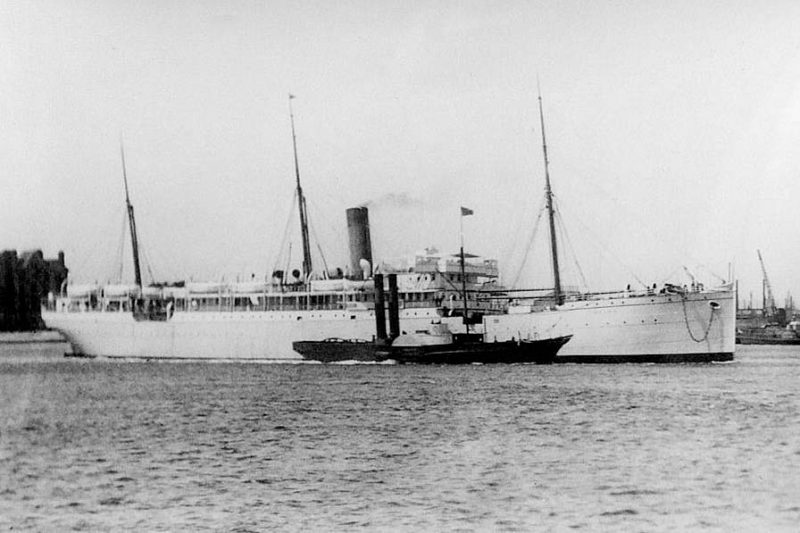
Galician was renamed Glenart Castle and German was renamed Glengorm Castle, but the rest of the Union Line fleet kept their names until they were sold off or scrapped. Moor sailed from Southampton on 10th March 1900 as the last vessel to depart in Union Line colours of white hull and yellow funnels as a mail steamer. A week later, the new houseflag was hoisted, firstly on board Dunottar Castle and then to the foremast of the intermediate steamer Gaika, which was berthed astern. Gaika sailed first, passing Dunottar Castle amidst reciprocal cheers. On 24th March 1900, Briton set sail in the Castle Line colours now adopted by the new company – vermilion red funnels with black tops and a lavender grey hull with red brown waterline.
The houseflag of the new company selected elements of both of the predecessor flags. The Castle Line houseflag was also the personal flag of Sir Donald Currie with his red ‘C’ in the middle of the white saltire. The red saltire of the Union Line was now superimposed on the white of Castle Line, and the blue field of the latter absorbed the border of the Union Line flag with the addition of a centrally placed white diamond to give a dramatic and eye catching houseflag.
Two of the large fleet of liners were lost within a few years of the amalgamation. The three masted Tantallon Castle of 5,636 grt completed in 1894 by the Fairfield yard was lost on 7th May 1901 at the end of a long voyage from Southampton. She encountered fog forty miles north of Table Bay and ran onto a shoal a few hundred yards to the northwest of Robben Island at 1520 hours. Capt. de la Cour Travers sounded the ship’s siren and fired distress rockets and guns. Calm was maintained on board until the local steamer Magnet arrived nearly two hours later and took off all 120 passengers and some crew members. All attempts by the remaining crew and harbour tugs to free the vessel were in vain and a few days later high Atlantic swells battered the vessel to pieces.
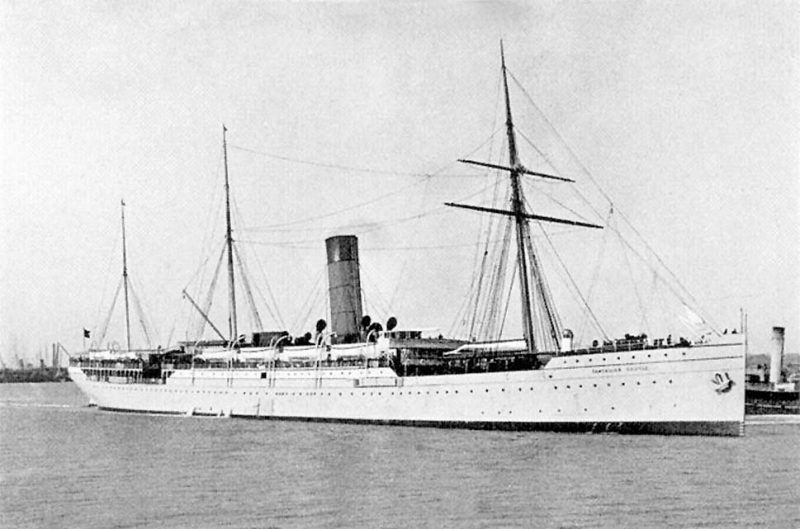
Newark Castle was one of four sisters built on the Clyde as an Intermediate steamer in 1901 by the Barclay, Curle & Co. Ltd. yard. She sailed from Durban on 12th March 1908 for Mauritius with 115 on board, 46 passengers and 69 crew. Six hours after leaving port, she ran aground in Richards Bay near the Umhlatuzi river. The sea was calm and the passengers were sent off in the lifeboats, with the Durban trawler Elelyn coming to the rescue early next morning, and she rescued all of the passengers from the boats, unfortunately one boat capsized and three lives were lost. The Master and most of the crew remained on board and with the assistance of a tug freed the liner. Newark Castle then drifted away and grounded again on a sandbank seven miles away, eventually becoming a total loss.
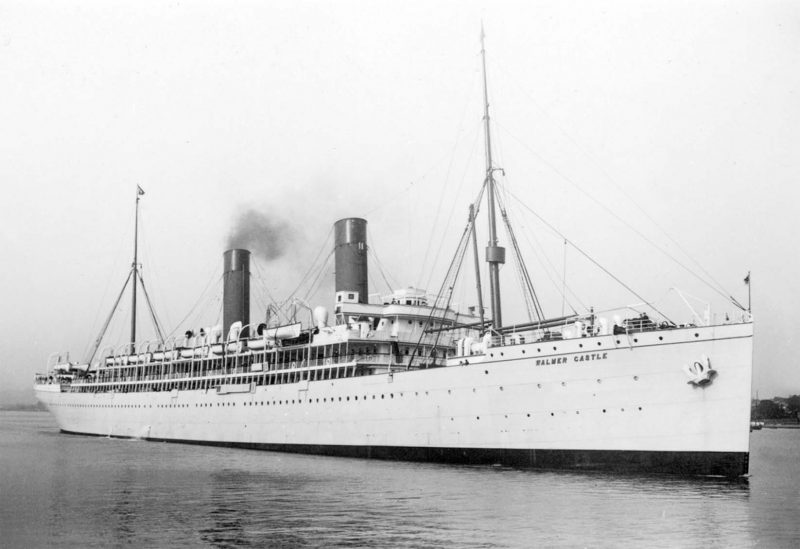
The last Union Line express mail steamer was to have been named Celt, but she was modified during building and completed in January 1902 as Walmer Castle, one of three sisters, the others being Armadale Castle and Kenilworth Castle. The trio were twin screw steamers with an overall length of 570 feet, beam of 64.3 feet. They reached their service speed of 17.5 knots from steam fed to twin quadruple expansion steam engines from ten boilers, eight of which were double ended in Walmer Castle with six double ended boilers in her two sisters. Coal bunker capacity was an enormous 3,384 tonnes, enough for the return voyage as well as the outward voyage. The passenger accommodation was 350 First Class, 200 in Second Class, and 270 in Third Class, with spacious and elegant public rooms for their entertainment. Lord Gladstone, the youngest son of deceased former Prime Minister William Ewart Gladstone, became the first Governor General of South Africa in 1910, and was carried on Walmer Castle to take up his appointment in Cape Town, and served for four years. Rudyard Kipling made over twenty sailings with Union-Castle Line, several of these being on this trio of sisters. Armadale Castle on her third voyage in 1904 became the first express mail steamer to cross the bar at Durban.
Dover Castle, Dunluce Castle and Durham Castle of 1904 were ‘Intermediate’ liners of 8,200 grt with accommodation for 230 First Class passengers ‘midships and 250 in Third Class aft. They came from the yards of three separate shipbuilders of Harland & Wolff Ltd., Belfast and the Clyde yards of Fairfield and Barclay, Curle. The trio were transferred to the London to Cape Town, Delagoa Bay and Mombasa route in 1910, with Durham Castle later having her Upper Boat Deck extended forward with space for an extra lifeboat. The trio saw much service in World War I as hospital ships at Gallipoli and Mudros and the other theatres of war.
Balmoral Castle and Edinburgh Castle were twin funnelled mail express liners built in 1910, but were basically modifications of the design of Norman of Union Line in 1894. This design had been used for three other Union liners, two Castle liners and four vessels after the amalgamation. Balmoral Castle and Edinburgh Castle were 63 feet longer and eleven feet wider than Norman at 570 feet in length and 64.5 feet moulded beam, but were beautifully elegant liners, and were recognisable by the absence of a break in the after superstructure. They were of 13,365 grt and with service speeds of fifteen knots from twin quadruple steam expansion engines had mail service passage times of 16.5 days to Cape Town. Balmoral Castle made history in 1910 by transporting the Duke of Connaught to South Africa for the inauguration of the Union of South Africa.
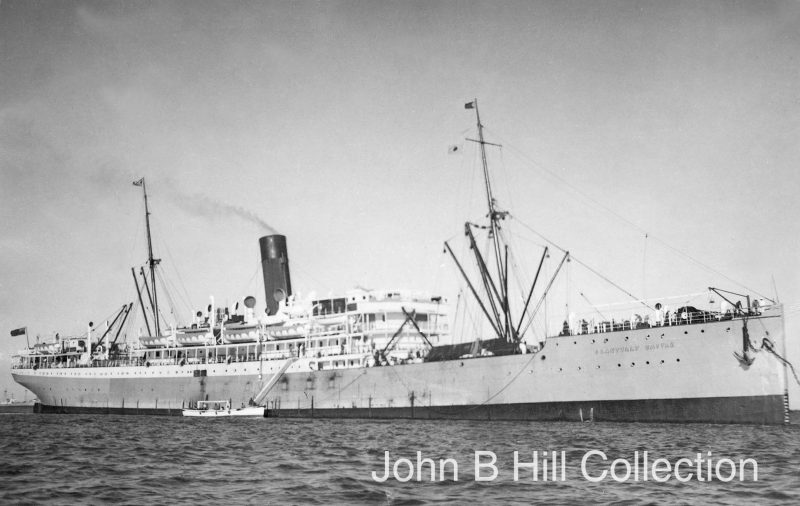
The five ‘G’ class of Grantully Castle, Garth Castle, Galway Castle, Guildford Castle and Gloucester Castle of 1910/11 were slightly smaller and slower than the three ‘Intermediate’ units of the ‘D’ class of 1904 at 7,750 grt with accommodation for 87 First Class passengers, 130 in Second Class, and 195 in Third Class, and thus reintroduced Second Class into the ‘Intermediates’. Grantully Castle and Garth Castle, the latter named after the Scottish home of Sir Donald Currie, were the last two ships ordered under the personal supervision of the deceased Chairman. They were given ‘G’ names to perpetuate the earlier ‘G’ class of Union Line, but were never as popular with the travelling public. Their ‘Intermediate’ speed of only thirteen knots from twin quadruple expansion steam engines was probably responsible for this, but they served with distinction as hospital ships during World War I at Gallipoli, Mudros, Scapa Flow, Cromarty Firth and the Firth of Forth. Gloucester Castle was fortunate to survive after being torpedoed in the English Channel on 31st March 1917 with the loss of three lives. However, her bulkheads remained watertight and she slowly made her way into Southampton Water for repairs. Garth Castle is also remembered for running aground on Ascension Island in 1926 with her passengers transferred to the mail steamer Kenilworth Castle, and with her forward two holds flooded after refloating, she made her way to Cape Town at only a few knots as her bow was down by almost nine feet.
Takeover By Royal Mail Line
Sir Donald Currie died at Dartmouth on 13th April 1909 aged 83 years and was buried at Fortingall in Perthshire, with his son-in-law Frederick Mirrielees, later knighted, taking over as head of Donald Currie & Company. It was announced in December 1911 that the Royal Mail Line and its subsidiary company, Elder Dempster, had made an offer of £32.50 for each £10 share in Union-Castle Line. A condition of the offer was that Donald Currie & Company resign as managers and agree not to enter the trade to South Africa for a period of ten years. The seven partners of Donald Currie & Company were each to receive £10,000 in way of compensation. Sir Owen Philipps (later Lord Kylsant), chairman of Royal Mail Line, took over the management of Union-Castle Line on 18th April 1912, with his Board consisting of eight directors comprising two from Union Line and two from Castle Line. The new Chairman immediately cabled the South African Government that he would negotiate for a new mail contract. The new contract was signed in September 1912 and with it the deferred rebate system ended. The contract covered not only the mail but also introduced reduced freight rates for certain South African agricultural products and a cool chamber for the carriage of fruit. Pedigree cattle were to be carried free of charge from the United Kingdom. The size of the mail steamers was to increase to 15,000 grt, and six would be built for the contract duration of ten years.
World War I
The First World War broke out in August 1914, with Union-Castle Line strength at 43 ships, but so great was the need for ships that at one time during the war only three cargo ships maintained the regular service to South Africa, the remainder being employed on war service. Carisbrook Castle, in reserve at Netley, was the first ship to be requisitioned for service as a hospital ship. Dunvegan Castle and Norman took the first troops of British Expeditionary Force to France on 10th August 1914, and Kinfauns Castle and Armadale Castle were converted into Armed Merchant Cruisers (A.M.C.) equipped with eight 4.7 inch guns. By 4th September 1914, 19 of the ocean going fleet of 41 steamers had been requisitioned for war service. On 27th August 1914, the largest convoy yet of merchant ships left Cape Town with 4,370 troops and their families on board. All of the ships were from Union-Castle Line and comprised Balmoral Castle, Briton, Dunluce Castle, Goorkha, Guildford Castle and Kenilworth Castle. The troops were from British Army regiments, the last to garrison South Africa.
On 15th September 1915, Galway Castle and Gaika, escorted by HMS Kinfauns Castle and HMS Armadale Castle, landed South African troops at Swakopmund to launch an invasion of German West Africa. At the Gallipoli invasion of 1915, Alnwick Castle and Galeka carried troops whilst Braemar Castle, Dunluce Castle and Gloucester Castle acted as hospital ships. By the end of 1915 there were no fewer than thirteen Union-Castle Line vessels in service as hospital ships, with Garth Castle as hospital ship to the Grand Fleet at Scapa Flow. Braemar Castle became base hospital ship at Murmansk for almost a year, and Kildonan Castle carried the Allied Mission to Russia in an unsuccessful attempt to prevent a separate peace between Russia and Germany. Unrestricted submarine warfare was declared on 1st February 1917, with Union-Castle Line suffering the following losses:
- Galeka struck a mine on 28th October 1916 and was damaged five miles NW of Cap de la Hague whilst on a voyage from England to Le Havre in service as a Hospital Ship, she was beached at Cap de la Hague and became a total loss, 19 lost.
- Alnwick Castle was torpedoed and sunk on 19th March 1917 310 miles from the Bishop Rock by U-81 whilst on a voyage from London to Cape Town, 40 lost.
- Dover Castle was torpedoed and sunk on 26th May 1917 in the Mediterranean fifty miles north of Bona by UC-67 whilst on a voyage from Malta to Gibraltar as a Hospital Ship, 7 lost.
- Aros Castle was torpedoed and sunk on 21st November 1917 300 miles from the Bishop Rock by U-90 whilst on a voyage from London to Baltimore in ballast, 2 lost.
- Carlisle Castle was torpedoed and sunk on 14th February 1918 eight miles NE of Royal Sovereign Lightvessel by UB-57 while on a voyage from Portland (Maine) to London with general cargo and grain, 1 lost.
- Glenart Castle was torpedoed and sunk on 26th February 1918 ten miles west of Lundy Island by UC-56 while on a voyage from Newport to Brest as a Hospital Ship, 168 lost including her Master.
- Leasowe Castle, the former Greek owned Queen Sophia, was torpedoed and sunk on 27th May 1918 in the Mediterranean 104 miles from Alexandria bu UB-51 while on a voyage from Alexandria to Marseille, 92 lost including her Master.
- Llandovery Castle was torpedoed and sunk on 27th June 1918 116 miles west of the Fastnet Rock while on a voyage from Halifax (NS) to Liverpool as a Hospital Ship, 234 lost.
- Galway Castle was torpedoed and sunk 160 miles from the Fastnet Rock by U-82 while on a voyage from Plymouth to Port Natal with general cargo, 143 lost.
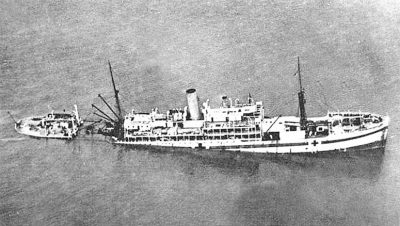
Leasowe Castle had been ordered by the National Steam Navigation Company of Greece from Cammell, Laird & Co. Ltd., but because of the shortage of ships was purchased by the British Government and managed by Union-Castle Line. She was employed in bringing troops that had fought in the Turkish campaign from Alexandria to Marseille. She was torpedoed at 0130 hours on 27th May 1918 on the starboard side in the after stokehold, the explosion killing some of the firemen and wrecking two of the boats. She was carrying 2,900 men of the Warwickshire Yeomanry and other Midland regiments, and in 45 minutes all of her forty lifeboats had been cleared away from the doomed ship with over two thousand men. A calm moonlit night had helped, but the after well deck was now awash and there was still a group of four hundred member stranded on the fo’c’stle. One of her escorting destroyers put her bow alongside her on the starboard bow and the men were told to jump the short distance across. However, a bulkhead gave way and the ship reared up and slid stern first under the water, with the destroyer just having time to cut herself loose. Capt. Holt, who had masterminded the orderly evacuation, went down with his ship, but there were remarkably few men lost considering the huge numbers on board.
In addition to the war service of this great fleet, the company equipped and maintained a factory for the manufacture of high explosive shells, and at the request of the Admiralty, undertook the stevedoring of war supplies from Southampton during the period from March to July 1917. Almost half a million tonnes of cargo, 77,000 horses, six thousand guns, plus tanks, lorries and road vehicles, were shipped in 610 steamers. During the first year of war, 100,000 troops were carried on company ships, and during the whole period of hostilities around 350,000 wounded men were brought home from France, the Persian Gulf and the Mediterranean, as well as 900 wounded prisoners of war.
‘Round Africa’ Service
The East African service of the company had begun on 13th September 1910 from London via the Suez Canal to terminate at Durban, using Guelph, Dunvegan Castle and Carisbrook Castle and joined by Goth and Gascon later. The pair of liners with Welsh names, Llandovery Castle and Llanstephan Castle of 11,400 grt, had been built in 1914 for the service, with Llandovery Castle a war loss in 1918. In October 1919, the weekly west coast mail service to Cape Town resumed with Carisbrook Castle and Norman as the fast express liners. A big fleet of 47 steamers was operated by the company at this time including a number of wartime standard ships acquired to replace war losses including Dromore Castle, Dundrum Castle, Ripley Castle and Rosyth Castle.
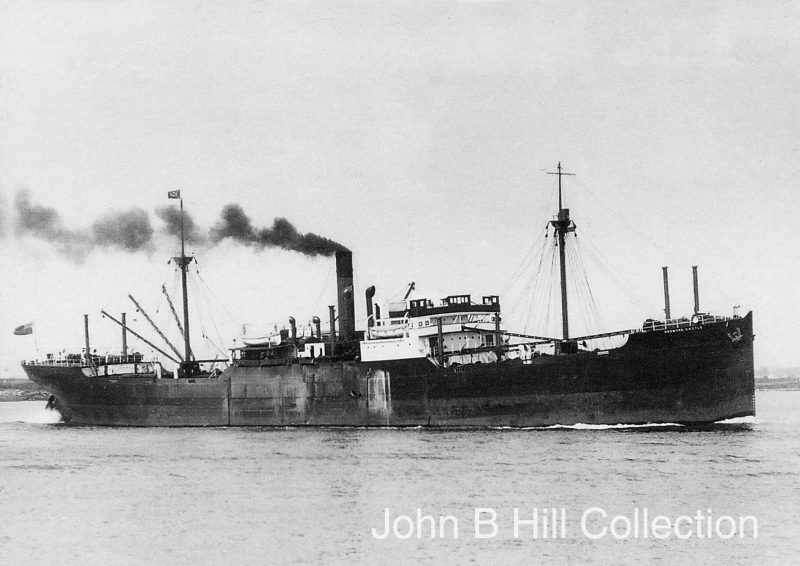
This big fleet served on two important routes:
(A) Express Mail and Intermediate services from England via Madeira, Las Palmas, Tenerife, Ascension Island, St. Helena, Lobito Bay to Cape Town, Mossel Bay, Knysana (near St. Francis Bay), Algoa Bay (Port Elizabeth), East London and Durban. The express mail steamers of course only called briefly at Madeira on their service from Southampton to Cape Town.
(B) London to Lisbon, Gibraltar, Marseille, Naples, Port Said and Suez Canal, and East African ports, Beira, Lourenco Marques and Durban.
The directors of the company in 1920 including the Chairman and Managing Director of Sir Owen Philipps, James Cameron-Head as Deputy Chairman, and Lord Pirrie of Harland & Wolff Ltd., and Edward Norton. The London loading berths were in the East India Dock Basin and at Tilbury, and a big network of 33 branch offices and agents in England, South and East Africa, and ports of call in the Mediterranean handled the booking of mail, passengers and cargo. Beira had its own passenger and cargo tender in Ipu of 686 grt, acquired in 1915 but built in Norway for the coastal Brazilian service of Empresa de Navegacion Lorentzen. The ‘Round Africa’ quintet of liners with Welsh names, Llanstephan Castle of 1914, Llandaff Castle and Llandovery Castle of 1925/26, and Llangibby Castle of 1929, and her near sister Dunbar Castle of 1930, were specially built for the ‘Round Africa’ service. Three of this quintet went ‘east about’ via the Mediterranean to East and South Africa returning via the Atlantic to England, while the other pair went ‘west about’ to Cape Town, South and East African ports returning via the Suez Canal and the Mediterranean to London for discharge.

Competition on the East African route was very keen with Deutsche Ost-Afrika Linie and Woermann Lines having some very smart, well fitted and fast ships on the route. British India Line had the traditional ‘M’ class on the route, but the ‘Llans’ of Union-Castle Line were in a class of their own. The single funnelled Llanstephan Castle of 1914 had accommodation for 195 First Class passengers, 165 Second Class, and 100 in Third Class. She and her sister were specifically designed for the East African service with airy, spacious and extremely comfortable cabins and public rooms, and passenger lifts to connect between them. The open Promenade and Boat Decks ‘midships were 235 feet in length, and the large amount of open deck space was a great boon for playing of deck games. She and her sister had three cargo holds and ‘tween decks forward, and two holds and ‘tween decks aft to carry 10,250 tonnes of cargo.
Llandaff Castle and sister Llandovery Castle were single funnelled steamers, but Llangibby Castle of 1929 was a twin funnelled motorship powered by twin eight cylinder four stroke single acting Harland & Wolff – B. & W. Diesels, with Buchi turbo chargers to give 30% more power and a service speed of 15.5 knots from twin propellers. She had seven decks in all, three of them of full length, named working downwards as Boat Deck, Upper Promenade Deck, Promenade Deck, Shade Deck, Upper Deck, Main Deck and Lower Deck. She had accommodation for 250 First Class passengers ‘midships and 200 Third Class passengers aft. The First Class Lounge, Smoking Room and Verandah Cafe were on the Upper Promenade Deck, and their staterooms on the Promenade Deck. The Main Deck aft was the promenade space for Third Class and the ship’s hospital was on the upper poop deck. The Shade Deck had First Class public rooms ‘midships, and Third Class public rooms aft, and both Dining Saloons were on the Upper Deck. The staterooms of both classes were of the ‘Bibby Tandem’ type with Third Class superior cabins being such an improvement of previous vessels on the ‘Round Africa’ route that they were renamed Tourist Class in 1934. She had an overall length of 507 feet, beam of 66.2 feet, with five holds and ‘tween decks, three forward and two aft, with the ‘tween decks and number five lower hold refrigerated for the carriage of citrus fruit. She had a carrying capacity of 8,465 tonnes with a thirty tonne heavy lift derrick on the foremast and twelve electric winches and derricks on the two masts and aft posts.
Express Mail Liners To Cape Town
The arrival of the four funnelled express mail liners Arundel Castle and Windsor Castle of 1922 in Cape Town caused a mixture of shock and admiration, as four funnelled liners had only previously been seen on the North Atlantic routes. The two new sisters were of a pre-war design but their completion had been heavily delayed by World War I. Arundel Castle was laid down at the Belfast yard of Harland & Wolff Ltd. on 11th November 1915, with her sister transferred at the same time to the Clydebank yard of John Brown & Co. Ltd. as the Belfast yard was unable to accommodate her. Arundel Castle was launched on 11th September 1919, and the internal layout of her public rooms particularly the Dining Room, and her cabins set the plan for all subsequent mail liners of the company until Pendennis Castle came into service in 1958. She had accommodation for 234 First Class passengers, 362 Second Class, and 274 in Third Class, with a crew of 440, giving a total when fully occupied of 1,310 persons on board.

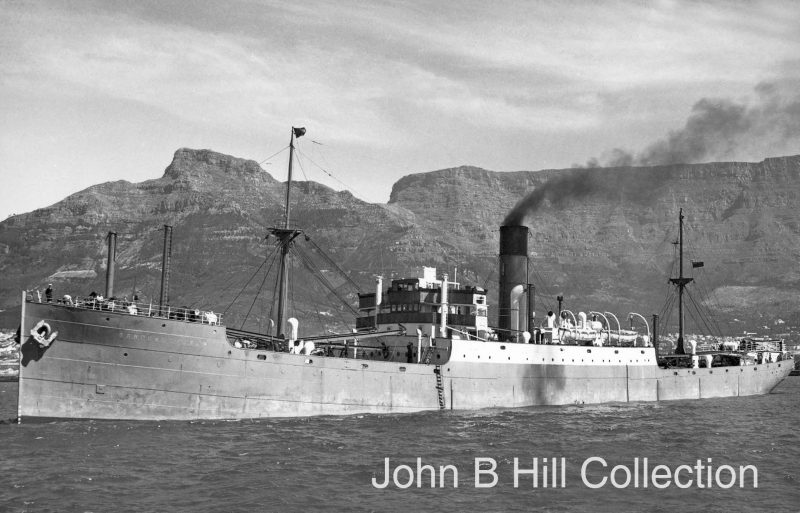
The passenger accommodation of Arundel Castle and Windsor Castle was light, spacious and comfortable, and included a swimming pool, luxury suites, cabins with private bathrooms, a passenger lift and a partly glazed Promenade Deck. The public rooms included separate Dining Room, Lounge, Saloon, Smoking Room and Reading and Writing Room for the three classes arranged on Bridge Deck, Upper Deck and Main Deck, with Third Class aft. Arundel Castle sailed from Southampton on her maiden voyage on Friday 22nd April 1921 and took only fifteen days to the Cape at her service speed of eighteen knots from two sets of three single reduction geared turbines of 15,000 shp and with a prodigious coal bunker capacity of 4,300 tonnes. The fourth funnel was a dummy but the two liners looked much smaller than their North Atlantic four funnelled counterparts when viewed together at Southampton. Windsor Castle sailed on her maiden voyage from Southampton in April 1922, and replaced the famous Union Line Norman of 1894. The only identifiable difference between Arundel Castle and Windsor Castle was a pair of kingposts at the bridge front of Windsor Castle. The pair were rebuilt in early 1937 into really beautiful liners with a longer new raked bow, two funnels replacing four, and were re-engined with Parsons turbines to give a three knot increase in speed as they were too slow for the new mail contract. The work was carried out at Belfast, with Arundel Castle re-entering service in October 1937 with her bridge wing houses removed, and was followed by her rebuilt sister three months later.
The twin funnelled motor liner Carnarvon Castle of 1926 when completed was a bit of an ‘ugly duckling’, but was a very fast ship and the Cape run record holder for sixteen years from 1938 to 1954. She had a dummy fore funnel and at 20,122 grt was the first company vessel to exceed 20,000 grt. She was launched at the Belfast yard of Harland & Wolff Ltd. on 14th January 1926 by Lady Suffield, second daughter of Lord Kylsant, and sailed from Southampton on 16th July 1926 on her maiden voyage to the Cape. She reached there at her service speed of nineteen knots in only 13.5 days, and had accommodation for 310 First Class passengers forward of ‘midships, 275 Second Class in the after end of ‘midships, and 266 in Third Class aft, with a crew of 350. She had an overall length of 655.9 feet, moulded beam of 73.5 feet, and depth of 41.7 feet, and was able to carry 15,790 tonnes of cargo in seven holds, three forward and four aft. She had three full length decks in her hull, an orlop deck outside the machinery spaces, a long fo’c’stle and a combined bridge and poop deck, with the Promenade and Boat Decks above. The public rooms featured a Dutch style of decoration, and the First Class Dining Room was a masterpiece stretching across the width of the ship on ‘B’ deck and held 288 passengers in one sitting.
As with Arundel Castle and Windsor Castle, Carnarvon Castle was turned into a really beautiful liner in 1937 during a reconstruction at her builders, which included lengthening by thirty feet, a new bow, and re-engining with twin ten cylinder diesel engines of 26,000 bhp for a speed of twenty knots. She reappeared with only a well raked single funnel, transforming the ‘ugly duckling’ into a veritable Cape express liner of some beauty. The overall length had gone up to 686.3 feet and she had finer lines and a beautiful curved raking bow, and passenger accommodation of 226 First Class passengers, 245 Second Class, and 188 in Tourist Class, with another four dozen berths interchangeable between First and Second Class. This new streamlined design set the standard for Union-Castle Line mail liners until the mid 1950s, and with her increased speed she set a new record of 12 days 13 hours and 38 minutes from the Nab Tower to Cape Town in July 1938, holding the speed record until 1954.
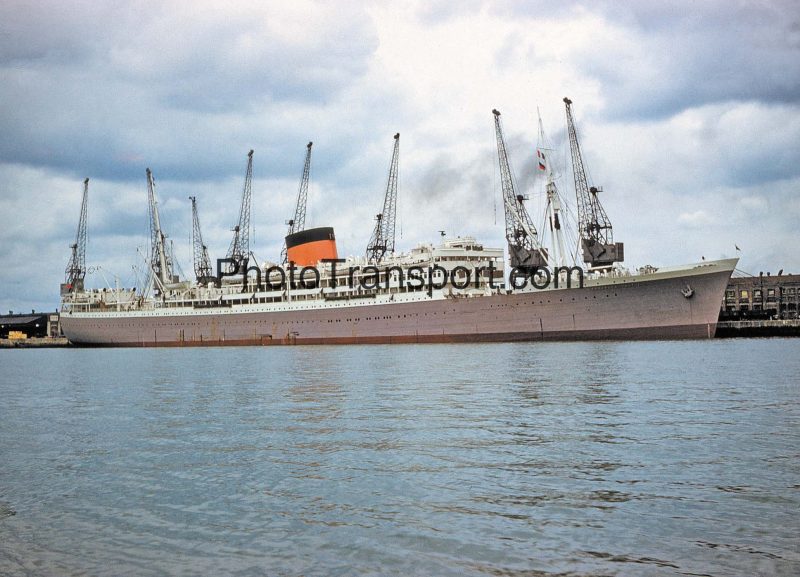
Warwick Castle and Winchester Castle of 1930 were also of just over 20,000 grt when completed by the Belfast yard of Harland & Wolff Ltd., and were twin funnelled motorships similar to Carnarvon Castle when she was first completed in 1926 but with some modifications. They were very popular with passengers on the Cape run, with many remembering the colourful Spanish decor and comfortable rocking chairs of the First Class public rooms of Winchester Castle. They were the last pair to be re-engined with new B. & W. Diesels of 26,000 bhp in 1938 to give a three knot increase in speed, but did not need lengthening as they had finer lines than Carnarvon Castle, and the only other modification was to fit a single raked motorship funnel.
Royal Mail Line Group Financial Crash
Union-Castle Line had been a member of the Royal Mail Line Group since 1912, with new Chairman Sir Owen Philipps (later Lord Kylsant) taking over many other British shipping companies e.g. Pacific Steam Navigation Company, Lamport & Holt, Glen Line, Shire Line, Elder Dempster, Nelson Line, British & African Steam Navigation Co. Ltd. and many others, and ordering many ships on credit terms from Harland & Wolff Ltd. at Belfast and Clydeside yards. The result was that by 1922, the Royal Mail Group was financially highly geared with over £25 million in loans still to be repaid at fixed interest rates of six per cent, giving annual interest payments of over one million pounds. By 1928, only a boom in freight rates could save the highly debt ridden Royal Mail Group, but the opposite happened with the most severe Depression ever experienced following the ‘Black Friday’ crash on Wall Street in late 1929. In fact, Royal Mail Line Group had been inherently unstable ever since Sir Owen Philipps had acquired Elder, Dempster in 1910. The Group collapsed during 1930 with the British Treasury involved in this disaster, and Lord Kylsant was forced to take ‘leave of absence’ from the Board in May 1931. He was then found guilty of issuing a false prospectus in 1928 aimed at re-launching the debt ridden debenture stock, and served a full year in prison.
It was only with the great business acumen of Sir Frederick Lewis of Furness, Withy & Co. Ltd., and Richard Durning of Blue Funnel Line, that the wrecked pieces of Royal Mail Line were picked up, and the assets of around two dozen British shipping companies were sold to transfer each fleet to new management. Robertson F. Gibb became Chairman of Union-Castle Line on 16th June 1932 but was at pains to point out the terrible state of the finances of Union-Castle Line resulting from the Kylsant involvement, but he also pointed out that the difficulties could and would be met and overcome. Confidence in the company returned and a turning point was reached, although no dividends were paid for some years. The needs of the preference shareholders of the company were met by the appointment to the Board of Sir Vernon Thomson, Chairman of King Line. The size of the Union-Castle Line was 32 vessels at the start of 1933, but was reduced by one when Guildford Castle collided with Stentor of Blue Funnel Line in the Elbe on 31st May, and she was beached with heavy damage and then broken up, with pilot error blamed for the collision. The last liner of the Union Line fleet, Saxon, was broken up in 1935 at Blyth after 35 long years of service. Union-Castle Line was able to start a £10 million programme in 1935 for the rebuilding of the passenger fleet over five years. However, the company now had Italian competition from a combine of liner companies formed in 1932 as Italia Line, which was granted a subsidy greater than that paid to Union-Castle Line for a mail service to South Africa from Italian ports.
Further Express Mail Liners And Refrigerated Cargo Ships
A large building programme was embarked upon by the company in 1935, comprising seven large mail and passenger liners, six refrigerated cargo ships, and the reconstruction and re-engining of five mail liners. In 1936, the mail contract to Cape Town was agreed with the South African Government to be speeded up from 16.5 days to just over thirteen days, served by eight express mail liners. Athlone Castle and Stirling Castle of 1936 were the most graceful of all Union-Castle Line mail liners, and were ordered at Belfast to fill two of the liner units in the new faster mail contract due to come into place in 1938. They were twin screw motorships able to comfortably cruise at a service speed of twenty knots with a maximum of 21 knots. They had accommodation for 300 First Class passengers and 490 in Cabin Class, with Stirling Castle launched first at Belfast on 15th July 1935 by Mrs. Robertson Gibb, wife of the Chairman. She arrived in Cape Town at the end of her maiden voyage in February 1936, and six months later took over the speed record of thirteen days and nine hours set by the record breaker Scot in 1893. Athlone Castle was launched at Belfast on 28th November 1935 by Princess Alice, the wife of the Earl of Athlone, who was the Governor General of South Africa. Athlone Castle is situated near Lough Rea in Westmeath to the west of Dublin, and has extensive grounds and estates. She arrived at Cape Town at the end of her maiden voyage in early June 1936.
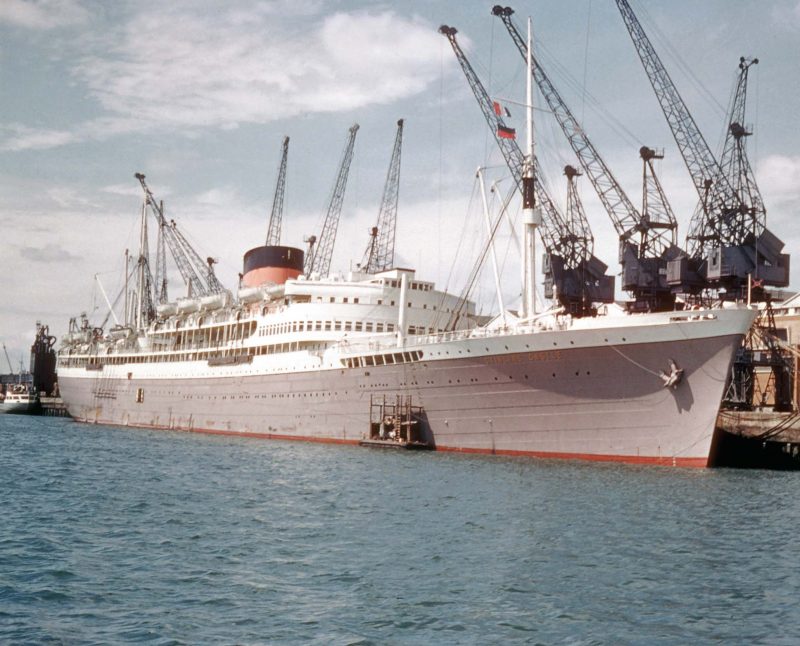
The height of the stylish and squat funnels of Athlone Castle and Stirling Castle was only 32 feet to give a low profile. They had four passenger decks with the First Class entrance bureau and public rooms at the forward end of these decks, and the Cabin Class entrance bureau and public rooms at the rear of these decks. The stylish First Class Dining Room and Cocktail Bar, and First Class Lounge and Smoking Room had large expanses of teak veneered panelling, and the decoration included artistic wall maps of Africa. The First Class Lounge had an unusual cut-away ceiling allowing a view into the room from a gallery in the deck above. Deck games were played on the Upper Sun Deck behind the bridge and in front of the funnel, and there was a very good safety provision of sixteen boats.
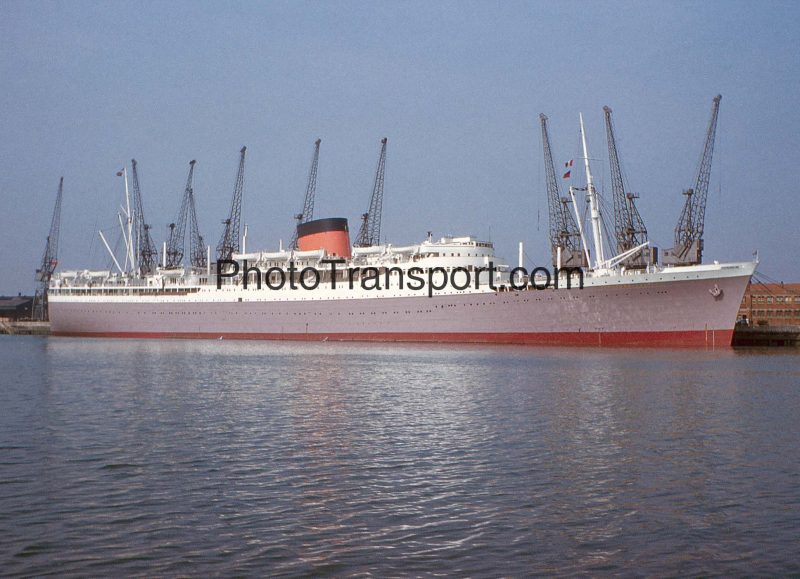
Capetown Castle of 1938 was a third unit of the Stirling Castle class, and was launched at Belfast on 23rd September 1937 by Mrs J.D. Low, Mayoress of Cape Town, but had more enclosed superstructure on ‘D’ deck to give more outside cabins, as well as sixteen more Cabin Class cabins. When she was delivered on 31st March 1938 she became the longest motorship in the world with an overall length of 734 feet and 38 feet longer than her two earlier near sisters. She was the last of a trio of sleek motor ships with, like all Union-Castle mail ships, a low profile in relation to their length. She sailed on her maiden voyage on Friday, 29th April 1938 taking her place in the new eight ship mail service. This called at Las Palmas on the outward voyage and Madeira on the homeward voyage. After the initial call at Cape Town, the liners proceeded to Mossel Bay, Port Elizabeth, East London and Durban, returning to Cape Town for a longer stay before the voyage home.
Dunnottar Castle and Dunvegan Castle of 1936 and 15,050 grt were completed in 1936 for the ‘Intermediate’ service with five holds, ten watertight bulkheads, and a service speed of 17 knots from twin nine cylinder two cycle B. & W. diesels of 9,500 bhp. They had accommodation for 258 First Class passengers and 250 in Second Class, and were notable in having electric engine room auxiliaries.
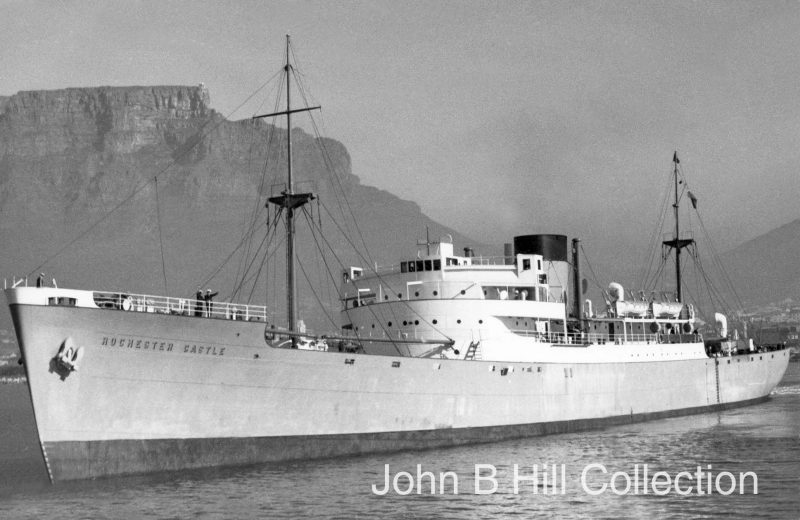
Durban Castle and Pretoria Castle of 1938/39 were of 17,382 grt and launched for the ‘Round Africa’ service with accommodation for 220 First Class passengers and 335 in Tourist Class. They introduced the practice of naming ships after non-existent South African castles, and had more enclosed superstructure than the Dunnottar Castle pair. On her second voyage in June 1939, Pretoria Castle damaged her rudder by a grounding at Delagoa Bay and was repaired in the Prince Edward Dock in Durban. Six refrigerated fruit cargo ships of between 7,800 dwt and 9,200 dwt were completed during 1935/39 as the ‘R’ (for refrigerated) class of Roslin Castle, Rothesay Castle, Rochester Castle, Roxburgh Castle, Richmond Castle and Rowallan Castle. They had five holds and five hatches, with two shelterdecks and an orlop and lower deck forward and abaft the engine room. A long bridge deck had no provision for passengers, and their lavender hulls had a pleasing profile and they were equipped with ten derricks of five tonne capacity on two masts and a pair of posts. They were usually laid up between citrus seasons, but still operated at a profit. Their seven watertight bulkheads extended to the upper deck, and this was to save some of the class from sinking during their arduous war service, particularly as fast ships on the Malta convoys.
World War II
A whole book could be written on the long war service and experiences of the crews of company vessels, tensed up and ‘on edge’ during periods of battle, or bored during long periods of inactivity on seemingly endless convoys. The company had a fleet of two dozen passenger vessels sailing from Southampton and London, and nine cargo ships, at the beginning of the war. In the days immediately preceding 3rd September 1939, Edinburgh Castle, the reserve steamer at Netley, was taken over for trooping, and Gloucester Castle also came out of reserve to take the mail service, which she did for three years along with some ‘Intermediate’ ships. Dunnottar Castle and sister Dunvegan Castle, Carnarvon Castle and Pretoria Castle were converted into Armed Merchant Cruisers (A.M.C.). The profile of Carnarvon Castle was to change greatly during the war, losing her two tall masts but gaining a short mast and two radar gantries, searchlight and rangefinder platforms, between her bridge and funnel, as well as the stump of her mainmast at her aft holds, and she bristled with eight guns of six inch calibre and two ‘AA’ guns of three inch calibre.
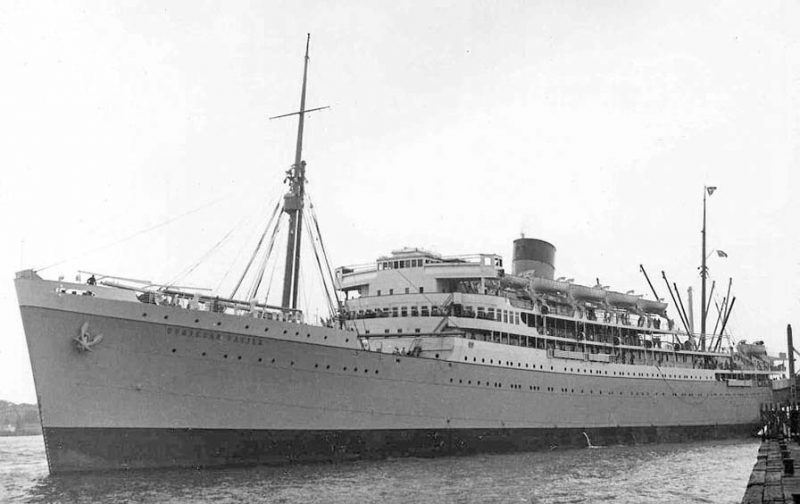
Carnarvon Castle was coated in grey paint and took up her patrol duties in the North and South Atlantic. She came to action stations on 5th December 1940 when 700 miles north east of Montevideo when the raider Thor was sighted. She opened fire at 0800 hours at a range of 14,000 yards, and fired over five hundred shells in a short action of just over one hour when the range had closed to only 8,000 yards. Thor was damaged and turned away as she did not want action, but the gunnery control of the Union-Castle Line ship had been smashed and her guns could only fire independently. She was on fire at numerous places by 0910 hours, and Thor saw her opportunity to slip away under a smoke screen, having fired 593 shells and two torpedoes, which missed. Four crew had been killed and 28 wounded on Carnarvon Castle from 27 shell bursts, and it took two hours for her fires to be brought under control and a course to be shaped for Montevideo. At the Uruguayan port, salvaged plates from the destroyed pocket battleship Graf Spee were used to temporarily patch her up during an agreed two day stay at this neutral port, and she then sailed for Cape Town for permanent repairs to continue her South Atlantic Patrol duties. She was converted into a troopship in early 1944, and ferried American troops to and from Europe for the next three years until March 1947. Thor was a lucky ship, surviving three actions with British A.M.C.s and escaping – 28th July 1940 with Alcantara, this action, and on 4th April 1941 she sank Voltaire of Lamport & Holt.
The Liner Requisition Scheme was introduced in January 1940 to operate on the same lines as in 1917, with all sailings centrally controlled and planned. The old favourite Edinburgh Castle became the Freetown accommodation ship and when no longer required was towed out to sea and sunk at the end of the war. Dunbar Castle was mined off Deal on 8th January 1940 and with her back broken she settled on an even keel to remain with most of her superstructure and her two funnels above water for the duration of the war, being demolished after the war. The captain was fatally injured when the foremast fell across the bridge, and he died later in one of the lifeboats, one other person was killed. Llangibby Castle was lucky to survive on 16th January 1942 while en route from the Clyde to Singapore with 1,400 troops as she was torpedoed by U-402 to the north of the Azores. The stern was blown off but remarkably her twin propellers were unscathed, and harried by enemy forces and steering only with her propellers, she reached Horta in the Azores for two weeks of temporary repairs, and then landed her troops at Gibraltar after being escorted by three destroyers and a tug. She eventually struggled back to the U.K., again without a rudder, and Capt. Bayer was later awarded the CBE for bravery. Llangibby Castle later played an important part in the D-Day landings of 6th June 1944 as a Landing Ship Infantry (LSI) on Juno beach equipped with eighteen landing craft, and then ferried 100,000 troops across the Channel in sixty voyages.

The grey painted company mail ships sailed in most of the big convoys of the war, including the largest trooping convoy to sail from the U.K. with 27 troopships on 24th March 1941 from the Mersey, as well as the big convoys of Operation Torch, the invasion of North Africa. Llanstephan Castle was commodore ship for the first Russian convoy of August 1941, sailing from Liverpool to Archangel and brought back two hundred Polish airmen. She was then present at troop landings in Burma and the East Indies as a Landing Ship Infantry (LSI) equipped with eighteen landing craft. Gloucester Castle, dating from 1911 and the oldest vessel in the fleet, was sunk by the raider Michel at night between the Gulf of Guinea and Ascension Island on 15th July 1942 in four minutes with the loss of 93 lives including her Master, Chief Engineer, purser, surgeon, all of her deck officers, and four of her twelve passengers.
Rochester Castle had the distinction of being the first of five survivors of Operation Pedestal to enter Valetta harbour in Malta in August 1942. Fourteen merchant ships were escorted by over fifty warships including two battleships, four aircraft carriers, seven cruisers and 25 destroyers. The enemy attacked with 230 aircraft, E-boats and submarines resulting in the loss of nine of the merchant ships, the survivors were the gallant Rochester Castle, Brisbane Star, Melbourne Star, Port Chalmers and the American tanker Ohio. The troop ship Warwick Castle was sunk on 12th November 1942 after landing her troops in North Africa and sailing homewards from Gibraltar in a convoy. She was hit by a torpedo from U-413 and sank in heavy seas with the loss of 63 officers and men including her brave Master, Capt. Shaw, who was pulled barely alive from a liferaft but died an hour later on a destroyer. Windsor Castle was hit by an aerial torpedo when in convoy 110 miles north west of Algiers on 23rd March 1943 with two thousand troops on board. Capt. Brown and 35 officers remained on board, and with two destroyers towing her, hopes were high that she could be beached. However, after twelve hours of towing she began to slowly sink stern first, fortunately only one man was lost during this time.
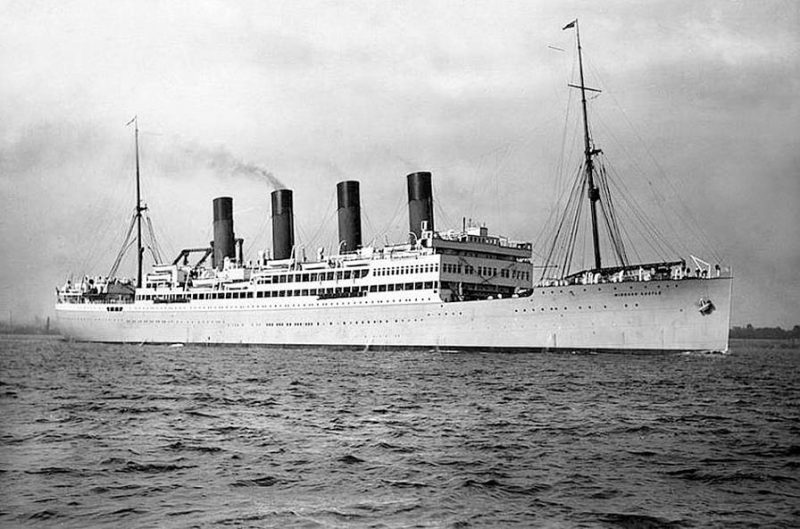
Mention must be made of two company coasters, the motorship Walmer Castle of 906 grt built in 1936 as a feeder vessel into London from Hamburg and Bremen, and the steamer Rovuma of 1,289 grt and 1,233 dwt built in 1927 for the East African service based at Beira. Walmer Castle was operational as a convoy rescue ship in September 1941, and on her first convoy she rescued 81 survivors from three sunken ships before she was mortally damaged by a direct bomb hit from a Focke-Wulf Condor aircraft on 21st September. The captain and ten crew were killed plus two of the survivors of sunken ships, with the derelict hulk sunk by Allied gunfire.
Rovuma was luckier as she remained on her East African duties throughout the war, and was sold for further South African duties in 1949 and she was broken up in 1962. A friend of mine made a three feet long scale model of her, with accurate representations of her ‘midships superstructure, her two masts and her six derricks of three tonne capacity on her two masts, plus a ten tonne heavy lift derrick on the foremast. The gorgeous lavender hull of the mail ships was also given to these two coasters.
At the end of the war, it was recorded that 274 Union-Castle Line personnel had lost their lives on board the ships that had been sunk, and 144 medals for bravery had been awarded together with 59 mentions in despatches. This tribute in battle honours can only go part of the way in giving the gratitude of the U.K. to the selfless devotion to duty of all their staff during the war.
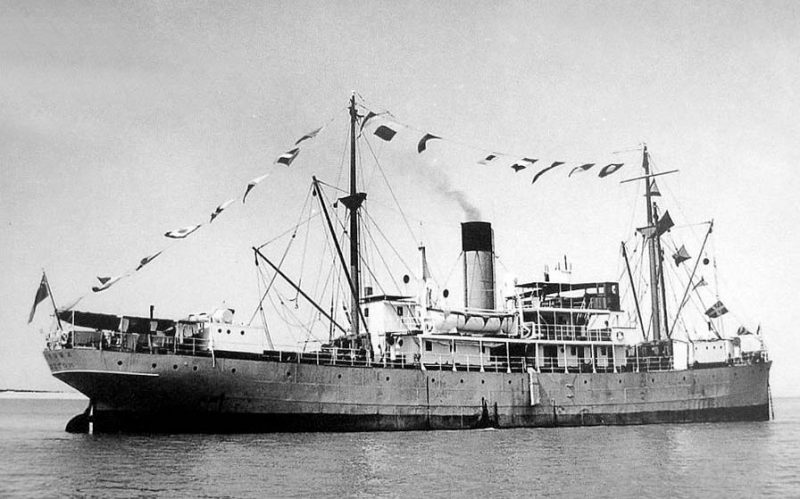
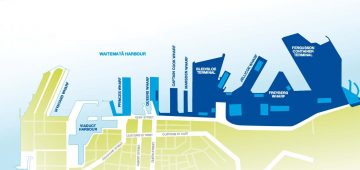



Comments
Sorry, comments are closed for this item